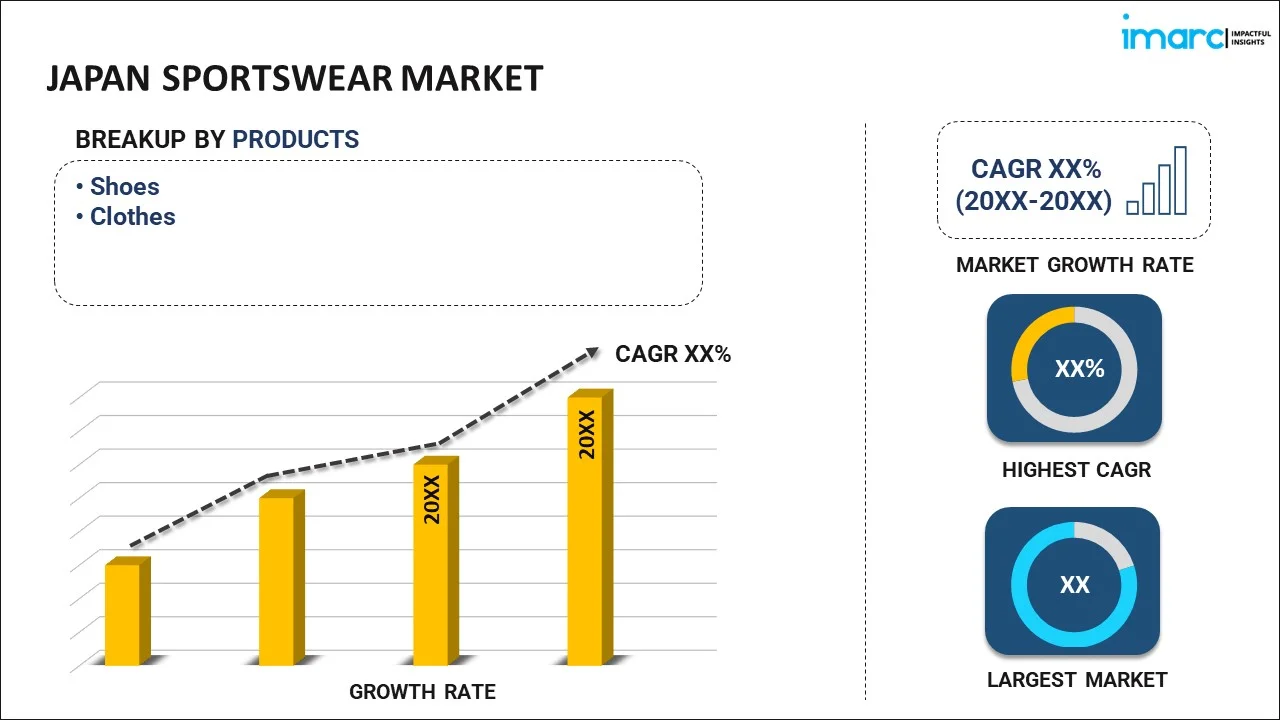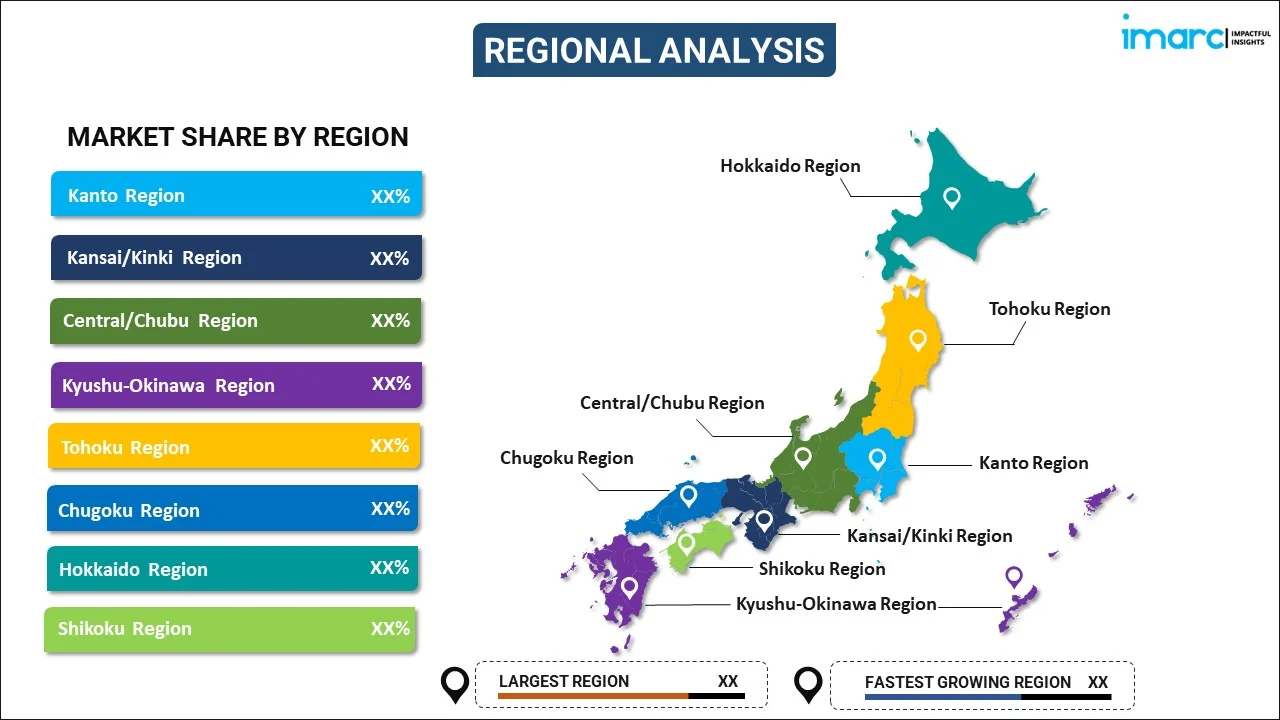
Japan Sportswear Market Report by Product (Shoes, Clothes), Distribution Channel (Online Stores, Retail Stores), End User (Men, Women, Kids), and Region 2025-2033
Market Overview:
Japan sportswear market size reached USD 6.9 Billion in 2024. Looking forward, IMARC Group expects the market to reach USD 11.9 Billion by 2033, exhibiting a growth rate (CAGR) of 5.7% during 2025-2033. The growing indulgence of individuals in sports and fitness activities, rising participation of women in sports and fitness activities, and increasing demand for sustainable and eco-friendly sportswear represent some of the key factors driving the market.
|
Report Attribute
|
Key Statistics
|
|---|---|
|
Base Year
|
2024 |
|
Forecast Years
|
2025-2033
|
|
Historical Years
|
2019-2024
|
| Market Size in 2024 | USD 6.9 Billion |
| Market Forecast in 2033 | USD 11.9 Billion |
| Market Growth Rate (2025-2033) | 5.7% |
Sportswear refers to clothing designed specifically for sporting and physical activities. It provides comfort and ensures safety during various forms of physical exercise. It includes a wide range of apparel, such as t-shirts, shorts, leggings, tracksuits, and specialized garments like compression wear. It also includes swimsuits, wetsuits, and rash guards for swimming, surfing, and diving. It often features moisture-wicking properties, helping to keep the wearer dry and comfortable. It is made with breathable fabrics to allow air circulation, preventing overheating and maintaining body temperature. It can withstand rigorous physical activity and repeated washing, making them more durable than regular clothing. It can improve performance by providing comfort, reducing drag, supporting muscles, and regulating body temperature. Besides this, it is used for hiking, mountain biking, and climbing due to its enhanced comfort. Moreover, as it offers improved blood circulation and muscle support, the demand for sportswear is increasing in Japan.
Japan Sportswear Market Trends:
The rising health consciousness among individuals and their increasing indulgence in fitness activities represent one of the primary factors stimulating the market growth in Japan. Additionally, the expanding aging population in Japan and its increasing participation in fitness activities are driving the demand for comfortable and supportive sportswear. Along with this, rising preferences of individuals for athleisure are strengthening the growth of the market in Japan. Apart from this, the increasing participation of women in sports and fitness activities is offering a favorable market outlook. Furthermore, the growing focus of sportswear companies on innovating fabrics and materials is influencing the market positively in the country. Moreover, the development of more comfortable, durable, and performance-enhancing sportswear is attracting a wider consumer base. Besides this, rising environmental concerns among the masses in Japan are driving the demand for sustainable and eco-friendly sportswear Besides this, the rise of online shopping platforms is making sportswear more accessible to a broader audience, contributing to the market growth. In addition, several leading brands in the country are increasingly investing in marketing strategies and promotional campaigns through celebrity endorsements and social media advertisements. In line with this, the integration of sportswear with fitness technology and apps is encouraging more people to engage in fitness activities. Furthermore, increasing collaborations between sportswear brands and designers or celebrities are attracting diverse consumers in the country. Moreover, the rising number of gyms, aerobic centers, and yoga and meditation classes is creating a positive outlook for the market in Japan. The escalating demand for sportswear suitable for at-home exercise regimes is also offering lucrative opportunities to industry investors in Japan.
Japan Sportswear Market Segmentation:
IMARC Group provides an analysis of the key trends in each segment of the market, along with forecasts at the country level for 2025-2033. Our report has categorized the market based on product, distribution channel, and end user.
Product Insights:

- Shoes
- Clothes
The report has provided a detailed breakup and analysis of the market based on the product. This includes shoes and clothes.
Distribution Channel Insights:
- Online Stores
- Retail Stores
A detailed breakup and analysis of the market based on the distribution channel have also been provided in the report. This includes online stores and retail stores.
End User Insights:
- Men
- Women
- Kids
The report has provided a detailed breakup and analysis of the market based on the end user. This includes men, women, and kids.
Regional Insights:

- Kanto Region
- Kansai/Kinki Region
- Central/ Chubu Region
- Kyushu-Okinawa Region
- Tohoku Region
- Chugoku Region
- Hokkaido Region
- Shikoku Region
The report has also provided a comprehensive analysis of all the major regional markets, which include Kanto Region, Kansai/Kinki Region, Central/ Chubu Region, Kyushu-Okinawa Region, Tohoku Region, Chugoku Region, Hokkaido Region, and Shikoku Region.
Competitive Landscape:
The market research report has also provided a comprehensive analysis of the competitive landscape. Competitive analysis such as market structure, key player positioning, top winning strategies, competitive dashboard, and company evaluation quadrant has been covered in the report. Also, detailed profiles of all major companies have been provided. Some of the key players include:
- Adidas Japan KK (Adidas AG)
- ASICS Corporation
- Descente Ltd.
- Mizuno Corporation
- Nike Inc.
- YONEX Co. Ltd.
(Please note that this is only a partial list of the key players, and the complete list is provided in the report.)
Japan Sportswear Market Report Coverage:
| Report Features | Details |
|---|---|
| Base Year of the Analysis | 2024 |
| Historical Period | 2019-2024 |
| Forecast Period | 2025-2033 |
| Units | Billion USD |
| Scope of the Report | Exploration of Historical Trends and Market Outlook, Industry Catalysts and Challenges, Segment-Wise Historical and Future Market Assessment:
|
| Products Covered | Shoes, Clothes |
| Distribution Channels Covered | Online Stores, Retail Stores |
| End Users Covered | Men, Women, Kids |
| Regions Covered | Kanto Region, Kansai/Kinki Region, Central/ Chubu Region, Kyushu-Okinawa Region, Tohoku Region, Chugoku Region, Hokkaido Region, Shikoku Region |
| Companies Covered | Adidas Japan KK (Adidas AG), ASICS Corporation, Descente Ltd., Mizuno Corporation, Nike Inc., YONEX Co. Ltd., etc. (Please note that this is only a partial list of the key players, and the complete list is provided in the report.) |
| Customization Scope | 10% Free Customization |
| Post-Sale Analyst Support | 10-12 Weeks |
| Delivery Format | PDF and Excel through Email (We can also provide the editable version of the report in PPT/Word format on special request) |
Key Questions Answered in This Report:
- How has the Japan sportswear market performed so far and how will it perform in the coming years?
- What has been the impact of COVID-19 on the Japan sportswear market?
- What is the breakup of the Japan sportswear market on the basis of product?
- What is the breakup of the Japan sportswear market on the basis of distribution channel?
- What is the breakup of the Japan sportswear market on the basis of end user?
- What are the various stages in the value chain of the Japan sportswear market?
- What are the key driving factors and challenges in the Japan sportswear?
- What is the structure of the Japan sportswear market and who are the key players?
- What is the degree of competition in the Japan sportswear market?
Key Benefits for Stakeholders:
- IMARC’s industry report offers a comprehensive quantitative analysis of various market segments, historical and current market trends, market forecasts, and dynamics of the Japan sportswear market from 2019-2033.
- The research report provides the latest information on the market drivers, challenges, and opportunities in the Japan sportswear market.
- Porter's five forces analysis assist stakeholders in assessing the impact of new entrants, competitive rivalry, supplier power, buyer power, and the threat of substitution. It helps stakeholders to analyze the level of competition within the Japan sportswear industry and its attractiveness.
- Competitive landscape allows stakeholders to understand their competitive environment and provides an insight into the current positions of key players in the market.
Need more help?
- Speak to our experienced analysts for insights on the current market scenarios.
- Include additional segments and countries to customize the report as per your requirement.
- Gain an unparalleled competitive advantage in your domain by understanding how to utilize the report and positively impacting your operations and revenue.
- For further assistance, please connect with our analysts.

 Inquire Before Buying
Inquire Before Buying
 Speak to an Analyst
Speak to an Analyst
 Request Brochure
Request Brochure
 Request Customization
Request Customization



.webp)




.webp)












